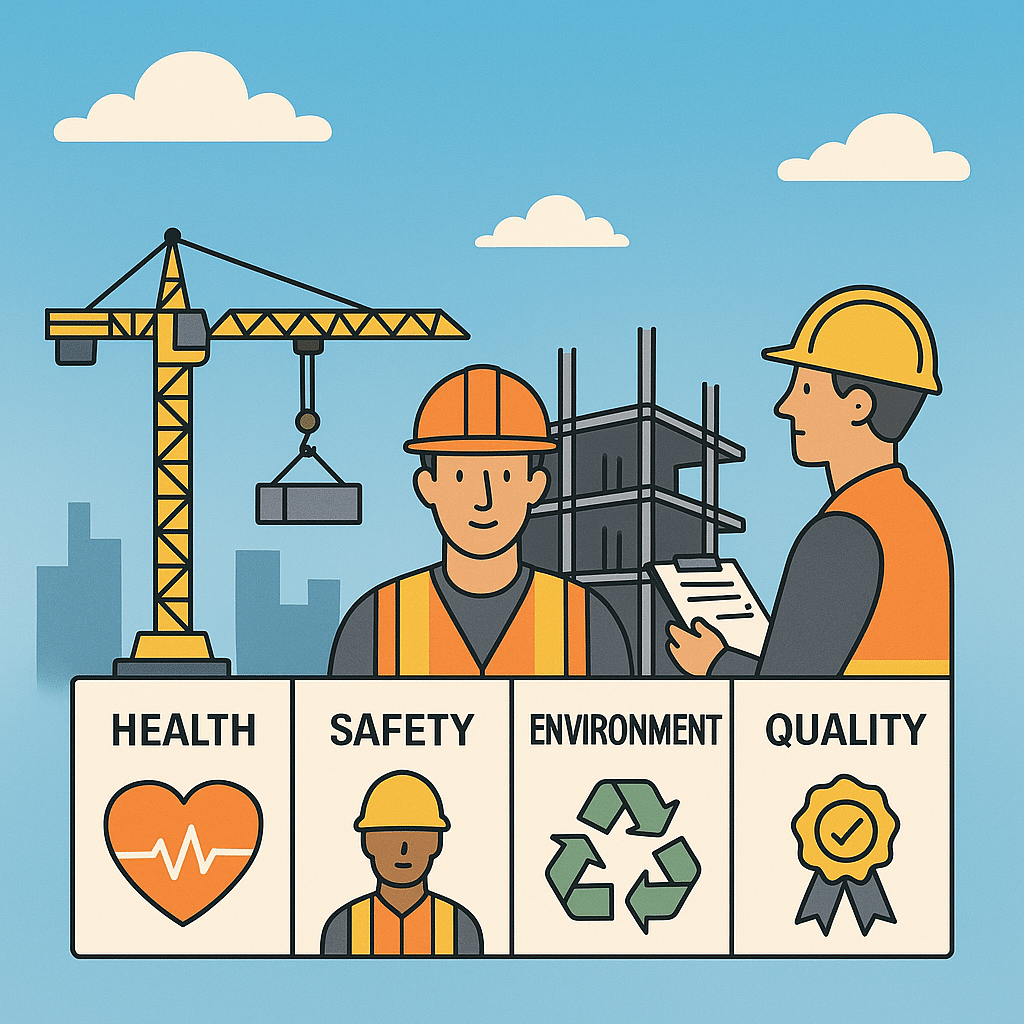HSEQ in Construction stands for Health, Safety, Environment, and Quality—four pillars that together form the backbone of safe, efficient, and compliant construction practices.
With construction sites among the most hazardous workplaces globally, integrating HSEQ is not just best practice—it’s a critical necessity.

High-hazard environments like high-rise projects, infrastructure builds, or tunneling work present unique risks. Falls from heights, equipment collisions, chemical exposure, and structural failures are real threats.
A robust HSEQ system can identify, evaluate, and control these hazards proactively, ensuring both worker safety and project success.
Understanding HSEQ in the Construction Context
Construction projects are dynamic and multifaceted. Workers perform multiple tasks involving heavy machinery, power tools, scaffolding, and environmental exposures.
HSEQ in construction ensures that every activity—from blueprint to handover—is guided by strategic controls for safety, environmental protection, and quality.
Health
Health risk management in construction extends beyond immediate injuries. It includes managing exposure to silica dust, asbestos, vibration, and noise—all linked to long-term illnesses.
Regular health monitoring and controls like PPE, ventilation, and job rotation help protect workers.
Safety
From excavation to crane operations, construction safety involves rigorous hazard identification, risk assessments, and control measures.
A dedicated construction safety program includes toolbox talks, permit systems, safety training, and near-miss reporting.
Environment
Environmental management on high-hazard sites means minimizing pollution, managing hazardous waste, and ensuring compliance with environmental laws.
Sediment control, fuel spill prevention, and green material use are key practices under HSEQ.
Quality
Quality isn’t just about the final structure. It’s about ensuring processes are followed, materials are tested, and standards are met throughout.
Poor quality can lead to rework, delays, or even structural failure—introducing serious safety risks.
Key Components of HSEQ in Construction Projects
Leadership Commitment
Effective HSEQ management starts with leadership. When project leaders prioritize safety, set expectations, and allocate resources to HSEQ initiatives, it sets the tone for the entire workforce.
Risk Assessment and Hazard Control
Thorough risk assessments must be conducted before and during all construction phases.
Hazards such as electrical lines, trench collapses, and falling tools should be evaluated using a hierarchy of controls: eliminate, substitute, engineer, administrate, and finally, use PPE.
Training and Competency
Well-trained workers make safer decisions. HSEQ training should cover:
- Working at heights
- Confined space entry
- Lockout/tagout procedures
- Equipment operation
- Emergency response
Training must be tailored for roles and include certifications required by WorkSafeBC, OSHA, or Canadian Centre for Occupational Health and Safety (CCOHS).
Incident Reporting and Investigation
A no-blame culture that encourages reporting of incidents, near-misses, and hazards is essential.
Investigating these reports allows root causes to be identified and corrective actions to be implemented.
Continuous Monitoring and Auditing
Regular site audits, HSEQ inspections, and performance reviews ensure systems are working effectively.
Tools like checklists, mobile apps, and real-time dashboards enhance visibility into on-site risks.
Real-World HSEQ Controls on High-Risk Construction Sites
| Hazard Type | Example Control Measures |
|---|---|
| Fall Hazards | Guardrails, fall arrest systems, edge protection |
| Chemical Exposure | MSDS access, storage cabinets, air monitoring, PPE |
| Equipment Hazards | Operator certification, spotters, exclusion zones |
| Fire and Explosion | Hot work permits, extinguishers, flammable storage |
| Environmental Risk | Erosion controls, dust suppression, noise monitoring |
Digital Tools for HSEQ in Construction
Technology is transforming construction HSEQ:
- Drones for site inspections and hazard identification
- Wearables to monitor worker fatigue or exposure
- Software platforms like SafetyCulture or EcoOnline for audits and compliance tracking
- BIM integration for pre-construction safety planning
These innovations improve data collection, transparency, and accountability across teams and contractors.
Regulatory Compliance and Industry Standards
Construction companies must align with regulations like:
- Canadian Occupational Health and Safety Regulations (SOR/86-304)
- WorkSafeBC Construction Requirements
- ISO 45001 (Occupational Health & Safety Management)
- CSA Z1000 OH&S Management Systems
These standards offer structured frameworks for managing HSEQ and are often mandatory for large-scale or government-funded projects.
Creating a Safety-First Culture on High-Hazard Sites
Building a zero-incident mindset involves everyone—from the crane operator to the project manager. Strategies to embed a safety culture include:
- Visible leadership engagement
- Peer-to-peer observations
- Safety incentive programs
- Inclusion of frontline workers in safety planning
Internal communications platforms (bulletin boards, mobile alerts, daily safety huddles) also help reinforce HSEQ values daily.
Linking HSEQ with Project Success
When HSEQ is prioritized, the benefits go beyond compliance:
- Reduced delays from injuries or non-compliance shutdowns
- Higher morale and retention of skilled workers
- Fewer insurance claims and lower premiums
- Improved public image and stakeholder trust
- Better quality outcomes and fewer reworks
Companies that embed HSEQ in every layer of construction—from procurement to punch-out—deliver better outcomes for all stakeholders.
To stay ahead in HSEQ management, leverage internal tools like your company’s safety portal or LMS. Also explore external sources such as:
- OHSE.ca – Canadian safety articles and resources
- CCOHS – Health and safety resources
- NIOSH Construction – U.S.-based safety research and tools
- Safe Work Australia – Global best practices
- ConstructConnect – Industry trends and innovations
These links provide up-to-date, dofollow resources to strengthen your knowledge base and compliance strategy.
Final Thoughts on HSEQ in Construction
HSEQ in Construction is not just a checklist—it’s a strategic framework to prevent harm, ensure environmental stewardship, and deliver quality projects.
High-hazard construction sites demand discipline, planning, and vigilance. Companies that champion HSEQ are rewarded with safer teams, fewer delays, and superior project outcomes.
A truly effective HSEQ system is proactive, adaptive, and embedded into the culture—not reactive or compliance-driven alone. By continuously improving your HSEQ efforts, you’re not only reducing risk—you’re building a legacy of excellence and care in the construction industry.
Leave a Reply